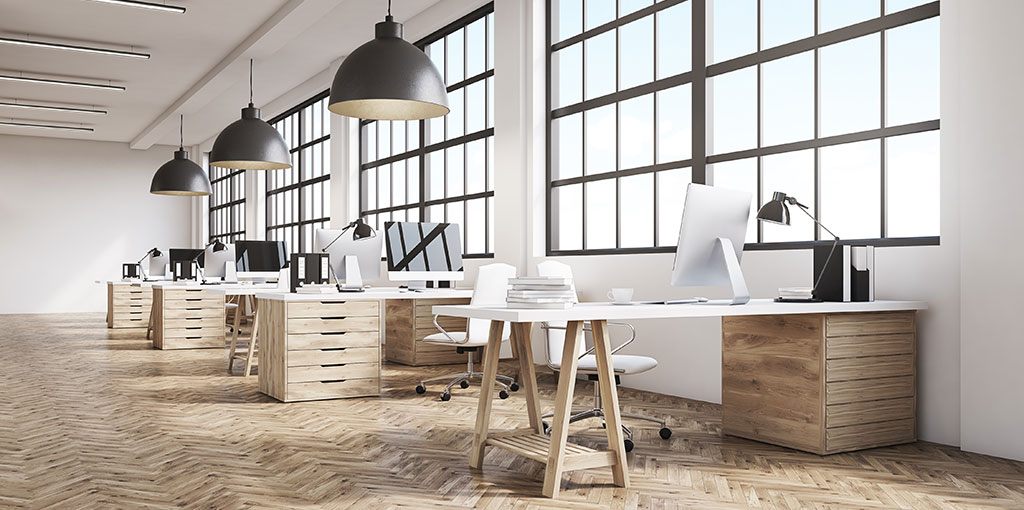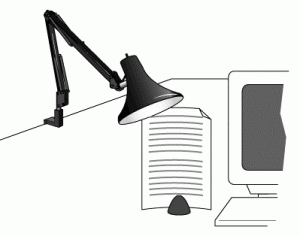Lighting in Ergonomics

When creating the perfect ergonomic workspace either in an office or an industry, every detail matters, including the positioning in relation to light sources. The placement of your workspace can significantly impact your comfort, productivity, and overall well-being. The ability to “see” at work depends not only on lighting but also on the time to focus on an object (fast-moving objects are hard to see, the size of an object (very small objects are hard to see), Brightness (too much or too little reflected light makes objects hard to see). [1] In this article, we’ll explore the importance of workspace positioning with respect to light and how strategic placement can enhance your ergonomic experience.
Different Sources of Light
Daylight: The quantity of daylight penetrating a building is influenced by various factors including its architectural design (presence, size, and orientation of windows), sunlight availability and direction, cloud cover, local topography, and seasonal variations. Natural light not only provides a pleasant ambiance but also offers numerous health benefits, including mood enhancement and vitamin D synthesis. Additionally, the cleanliness of windows plays a significant role.[2] Techniques like tinted glass, window blinds, curtains, and awnings offer means to regulate the amount of daylight entering a workspace. When positioning your workspace, aim to place it perpendicular to windows to minimize glare and maximize exposure to natural light throughout the day.
Electric Lighting: Electric lighting systems determine the quantity and quality of light, including its color temperature and rendering of object colors. It’s important to note that inadequate lighting can also pose challenges. Thus, a reliable electric lighting system is indispensable even in environments blessed with natural light.

Ergonomic Lighting Tips to Enhance Your Workspace
- Utilize Natural Light: Position your workspace near windows or skylights to maximize exposure to natural light. Natural light promotes alertness, enhances mood, and reduces the reliance on artificial lighting during the day.
- Reduce Glare: Position your desk so that windows or bright light sources are not directly in front of or behind you to minimize glare on screens and surfaces. Use curtains, blinds, or diffusers to control the amount of light entering the space.
- Adjustable Task Lighting: Invest in adjustable task lighting fixtures that can be positioned to illuminate specific work areas, such as your desk or keyboard. Adjustable lighting allows you to customize the intensity and direction of light according to your needs and preferences.[3]
- Avoid Harsh Overhead Lighting: Harsh overhead lighting can create glare and shadows, leading to eye strain and discomfort. Use indirect or diffused overhead lighting to create a softer, more uniform illumination in the workspace.
- Balance Lighting Levels: Ensure a balance of lighting throughout the workspace by combining natural light with artificial lighting sources. Adjust the brightness levels of artificial lighting to complement natural light and maintain consistent illumination throughout the day.
- Task-Specific Lighting: Use task-specific lighting for activities that require focused attention, such as reading or detailed work. Position task lights to provide direct illumination on work surfaces while minimizing glare and shadows.

- Consider Color Temperature: Choose lighting with a color temperature that suits the tasks performed in the workspace. Cooler color temperatures (e.g., daylight or cool white) are ideal for tasks requiring focus and concentration, while warmer color temperatures (e.g., soft white) create a more relaxing ambiance for casual activities. [4]
- Reduce Screen Glare: Position computer screens perpendicular to windows to minimize glare from natural light. Consider using anti-glare screen filters or adjusting the screen angle to reduce reflections and glare.
- Take Breaks in Natural Light: Incorporate short breaks outdoors or in areas with ample natural light to rest your eyes and rejuvenate your mind. Exposure to natural light during breaks can help reduce eye strain and improve overall well-being.
- Adjust for Individual Preferences: Customize lighting settings to accommodate individual preferences and sensitivities.
- Encourage employees to adjust lighting levels and fixtures according to their comfort and productivity needs.
Ergonomic Exercises for the Eyes While Working
- 20-20-20 Rule: Every 20 minutes, take a 20-second break and look at something 20 feet away. This exercise helps reduce eye strain and relaxes the focusing muscles. [5]
- Eye Rolling: Gently roll your eyes in a circular motion clockwise, then counterclockwise. Repeat this movement several times to help relax the eye muscles and improve circulation.
- Blinking: Blinking helps moisturize and refresh the eyes. Make a conscious effort to blink more frequently to prevent dryness and irritation, especially when focusing on digital screens.
- Palming: Rub your hands together to generate warmth, then gently cup your palms over your closed eyes without applying pressure. Relax and breathe deeply for 20-30 seconds while visualizing darkness. This exercise helps relieve tension and soothe tired eyes.
- Eye Exercises Apps: Consider using an eye exercise app like the OOHMS Break App that offers guided 3D exercises specifically designed to reduce eye strain and improve visual comfort as well as a wide range of other 3D exercises that target different parts of the body.
The positioning of your workspace with respect to light sources is a critical factor in creating a comfortable and ergonomic environment. Whether harnessing the benefits of natural light or strategically placing task lighting fixtures, thoughtful workspace positioning can enhance your overall comfort, productivity, and satisfaction. To learn more about ergonomics, OOHMS has created a full course on ergonomics as well as other health-related courses that discuss how to apply ergonomic principles into your workday.
To learn more about our courses visit https://oohms.duergointernational.com/courses-available/ .
